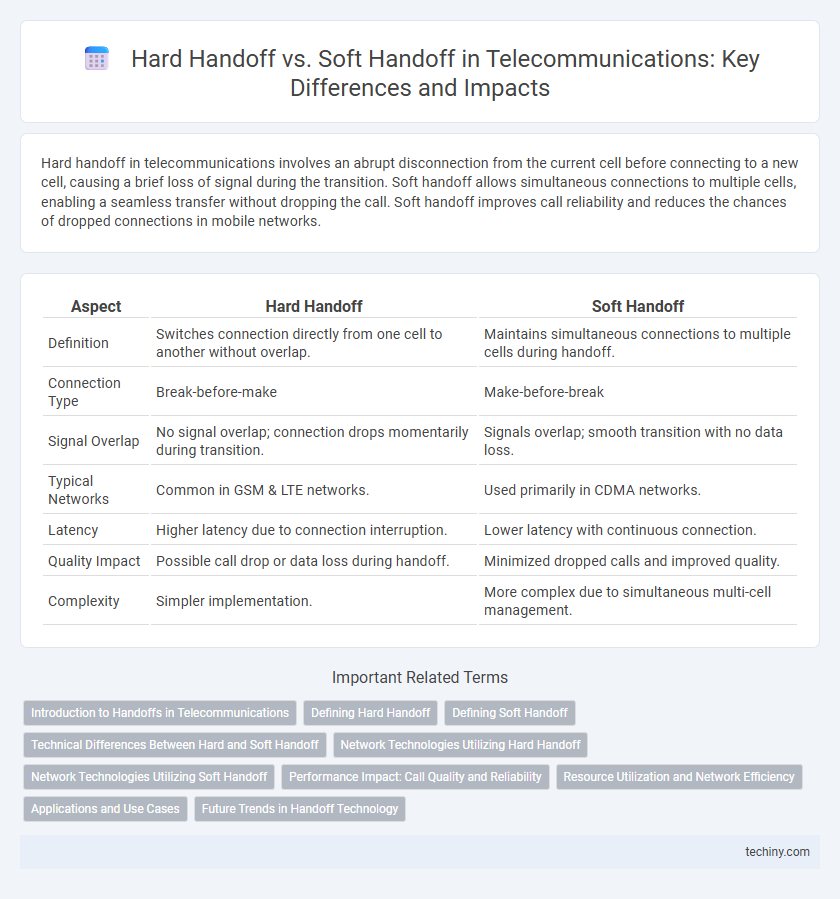Hard handoff in telecommunications involves an abrupt disconnection from the current cell before connecting to a new cell, causing a brief loss of signal during the transition. Soft handoff allows simultaneous connections to multiple cells, enabling a seamless transfer without dropping the call. Soft handoff improves call reliability and reduces the chances of dropped connections in mobile networks.
Table of Comparison
| Aspect | Hard Handoff | Soft Handoff |
|---|---|---|
| Definition | Switches connection directly from one cell to another without overlap. | Maintains simultaneous connections to multiple cells during handoff. |
| Connection Type | Break-before-make | Make-before-break |
| Signal Overlap | No signal overlap; connection drops momentarily during transition. | Signals overlap; smooth transition with no data loss. |
| Typical Networks | Common in GSM & LTE networks. | Used primarily in CDMA networks. |
| Latency | Higher latency due to connection interruption. | Lower latency with continuous connection. |
| Quality Impact | Possible call drop or data loss during handoff. | Minimized dropped calls and improved quality. |
| Complexity | Simpler implementation. | More complex due to simultaneous multi-cell management. |
Introduction to Handoffs in Telecommunications
Handoffs in telecommunications are crucial processes that maintain uninterrupted service when a mobile device moves between cell coverage areas. Hard handoff involves a break-before-make connection, disconnecting the current cell before connecting to the next, typically used in GSM networks. Soft handoff allows simultaneous connections to multiple cells during the transition, enhancing call quality and reliability, and is commonly implemented in CDMA systems.
Defining Hard Handoff
Hard handoff in telecommunications refers to the process where a mobile device disconnects from the current cell before connecting to a new cell, resulting in a break-before-make transition. This type of handoff is commonly used in Frequency Division Multiple Access (FDMA) and Time Division Multiple Access (TDMA) networks, where channels operate on separate frequencies or time slots. The inherent interruption during hard handoff can lead to brief call drops or data session pauses, distinguishing it from the seamless transition seen in soft handoff scenarios.
Defining Soft Handoff
Soft handoff occurs when a mobile device simultaneously connects to multiple base stations during a call, ensuring seamless transition and minimal call drops. This technique relies on overlapping cell coverage areas, allowing signals from different towers to be combined and used for improved call quality. Soft handoff is predominantly employed in CDMA and WCDMA networks to enhance reliability and maintain continuous communication.
Technical Differences Between Hard and Soft Handoff
Hard handoff involves a break-before-make connection where the mobile device disconnects from the current cell before connecting to the next, resulting in potential call drops during the transition. Soft handoff uses a make-before-break approach, allowing simultaneous connections to multiple base stations, which improves call reliability and reduces dropped calls. Technically, hard handoff is commonly used in GSM networks, while soft handoff is predominant in CDMA networks due to their different channel allocation and signal processing methods.
Network Technologies Utilizing Hard Handoff
Network technologies utilizing hard handoff include GSM (Global System for Mobile Communications) and CDMA (Code Division Multiple Access) in early generations where mobile devices switch connections by breaking the current link before establishing a new one. Hard handoff involves a quick, singular transition from one cell to another, minimizing signal overlap and reducing complexity in cellular network management. This method contrasts with soft handoff used in CDMA networks, where simultaneous connections to multiple cells allow smoother transitions but require more sophisticated coordination.
Network Technologies Utilizing Soft Handoff
Soft handoff is primarily utilized in CDMA (Code Division Multiple Access) and WCDMA (Wideband Code Division Multiple Access) network technologies, allowing mobile devices to simultaneously connect to multiple base stations for seamless transition during calls. This technique enhances call reliability and reduces dropped connections by maintaining overlapping signal coverage areas. Unlike hard handoff, which involves a break-before-make connection switch, soft handoff provides smoother mobility and better handling of interference in 3G and certain advanced cellular networks.
Performance Impact: Call Quality and Reliability
Hard handoff typically results in brief call interruptions due to the abrupt disconnection from the current cell before connecting to the next, potentially affecting call quality and reliability. Soft handoff maintains simultaneous connections with multiple cells during the transition, enhancing call continuity and reducing dropped calls by minimizing signal degradation. Consequently, soft handoff generally provides superior performance in terms of call quality and network reliability, especially in densely populated or highly mobile environments.
Resource Utilization and Network Efficiency
Hard handoff requires exclusive channel allocation during the transition between cells, leading to higher resource consumption and potential call drops, which decreases overall network efficiency. Soft handoff allows simultaneous connections to multiple base stations, optimizing resource utilization by leveraging overlapping coverage, enhancing call continuity, and reducing dropped calls. Consequently, soft handoff improves network capacity and maintains higher quality of service in CDMA-based cellular networks.
Applications and Use Cases
Hard handoff is predominantly used in GSM networks and LTE systems where a clear break-before-make approach ensures minimal interference during cell transitions, optimizing voice call continuity in urban environments. Soft handoff is favored in CDMA and WCDMA networks, providing simultaneous connections to multiple base stations to enhance signal quality and reduce dropped calls, especially in high-mobility scenarios such as highways or railway systems. Telecommunications providers leverage hard handoff for efficient spectrum utilization, while soft handoff applications focus on improving user experience in dense coverage areas with fluctuating signal strengths.
Future Trends in Handoff Technology
Future trends in handoff technology emphasize the integration of machine learning algorithms to predict user mobility patterns, enhancing the efficiency of hard handoff and soft handoff processes in 5G and beyond networks. Advanced network architectures leveraging edge computing enable ultra-low latency handoffs, ensuring seamless connectivity during high-speed transitions. The adoption of AI-driven network slicing facilitates dynamic resource allocation, optimizing handoff decisions to improve overall quality of service in heterogeneous wireless environments.
Hard handoff vs Soft handoff Infographic

 techiny.com
techiny.com